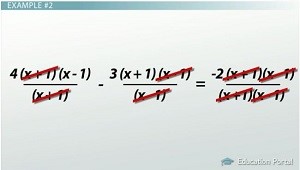In example #1, the first step is finding the common denominator.
Distribute to simplify: (3x - 6) + (4x + 12) = 2x - 4. Collect like terms and solve. 3x + 4x = 7x, -6 + 12 = 6. We end up with 7x + 6 = 2x - 4.
Subtract 2x from both sides: 7x - 2x = 5x. Subtracting from the other side just cancels out the 2x, and we get 5x + 6 = -4. Subtract 6 from both sides: -4 - 6 = -10. Again, subtracting 6 will cancel out the +6, so we end up with 5x = - 10. Divide by 5 on both sides, and we cancel out the 5 and give us x = - 2. It turns out x = - 2.
The reason we check our answers is that sometimes we get a virus, or, in math terms, extraneous solutions. To check, I replace all the xs with -2: (3 / (-2 + 3)) + (4 / (-2 - 2)) = (2 / (-2 + 3)). Let's simplify: (3 / 1) + (4 / -4) = (2 / 1). Since 3 + -1 = 2 is true, x = - 2 is the solution!
Example #2
Example number two: solve. Remember to check for extraneous solutions. (4 / (x + 1)) - (3 / (x - 1)) = -2 / (x^2 - 1).
First we need to release our denominators. To release our denominators, we write down every denominator we see. I have found the easiest way to do this is to first factor, if needed, then list the factors. x^2 - 1 = (x + 1)(x- 1).
Our new equation looks like this: (4 / (x + 1)) - (3 / (x - 1)) = -2 / (x + 1)(x - 1).
I look at 4 / (x + 1). I write down (x + 1) as one of my common denominators. I look at 3 / (x - 1). I write down (x - 1) as another part of my common denominator. I look at -2 / (x + 1)(x - 1). Since I already have those written in my denominator, I don't need to duplicate them. So my common denominator turns out to be (x + 1)(x - 1).
Kathryn, why aren't we using the factors of x^2 - 1? Great question! We already have (x + 1) and (x - 1) being released. We don't need to do it twice.
Now we multiply each part of the equation by the common denominator - (x + 1)(x - 1). Think of this as the key to the prison: (4 (x + 1)(x -1) / (x + 1)) - (3 (x + 1) (x - 1) / (x - 1)) = -2 (x + 1)(x - 1) / (x + 1)(x - 1).
It isn't easy for the denominators to be released; there is a battle, and like terms get canceled (or slashed)! Slash (or cancel) all of the (x + 1)s and (x - 1)s in the denominator and numerator. This leaves us with 4(x - 1) - 3 (x + 1) = -2.

Like terms are cancelled out or slashed in the second example.
Now we need to solve for x. Distribute 4 into (x - 1) and -3 into (x + 1). (4x - 4) - (3x - 3) = -2. Collect like terms: x - 7 = - 2. Add 7 to both sides of the equal sign: x = 5.
It looks like our answer is 5, but we need to double-check. I replace all the xs with 5 and simplify. It turns out 5 works, and it is the solution to our equation. And so our solution checks!
Lesson Summary
The steps to solving a rational equation are:
- Find the common denominator.
- Multiply everything by the common denominator.
- Simplify.
- Check the answer(s) to make sure there isn't an extraneous solution.